Voxan and Max Biaggi Set 11 New Electric World Records

The Voxan Wattman reaches 254 mph
French motorcycle manufacturer Voxan recently set no less than eleven world records with its electric land speed racer, the Wattman. The pilot? None other than multi-time world champion Max Biaggi. The world record attempt took place over the three days spanning October 30 – November 1 on the 2.17-mile airstrip at the Châteauroux airfield in France, not far from the team (and Biaggi’s) HQ in Monaco. The team originally aimed at making its run at the Salar de Uyuni salt flats in Bolivia, the largest in the world but, well, coronavirus.
From the onset, the Voxan team had a primary goal it wanted to achieve: 330 km/h (204 mph). If Biaggi could manage to pilot the Wattman to this number, it would beat the previous “partially streamlined electric motorcycle over 300 kilos” class record, held by Ryuji Tsuruta and Mobitec EV-02A with their speed of 329 km/h (204 mph).
Not only did Biaggi hit the target, he smashed it, recording an average speed of 366.94 km/h (228.05 mph), per the FIM rules, which state the vehicle has to record speeds in both directions, with the final speed being the average of both runs. Equally impressive, then, is the 408 km/h (254 mph) Biaggi and the Wattman were able to achieve during one of its runs in a single direction.
So, what is the Voxan Wattman, and how did it go about getting 11 records? Read on for a little history lesson and tech dive.
Background
Americans may not be familiar with the Voxan name since its motorcycles were never sold stateside, but the boutique french motorcycle manufacturer was founded in 1995 and has pumped out some stylistically evocative and bold models over the years like the original Roadster, Café Racers, Scramblers, and the Black Magic – all powered by a 996cc, 72º V-Twin. (On a side note, on a trip to France several years ago, I got to ride a Voxan Black Magic very briefly. I don’t remember much from the ride, honestly, but I do remember the engine was sporty and athletic with decent power…)
In late 2009, 14 years after it was founded, Voxan was forced into liquidation. Less than a year later Voxan was purchased by Gildo Pastor, President of the Venturi Group, known for its high-performance electric vehicles, including the car it campaigns in the all-electric Formula E car racing series. This would set the tone for the future of Voxan. Immediately, the new Voxan switched from internal combustion to electric propulsion.
The first item on the list? Setting some world records.
The Bike
The Voxan Wattman was a clean-sheet design built for a single purpose – straight-line speed. Because of this, there are some key differences between a land-speed racer and, say, a road race bike someone like Biaggi would be more familiar with, apart from the batteries obviously. As mentioned before, 330 km/h was the target. Aerodynamics would be essential, of course, but stability at speed would also be crucial.
We’re all familiar with land speed racers; they’re long and low. With the Wattman, the streamlined bodywork went to the wind tunnel, of course, but much more time was spent running computer simulations and crunching different calculations. That’s all well and good, except those calculations only provided information at speeds up to about 240 km/h (150 mph). How the bodywork would react at nearly 70 mph faster was a bit of an unknown, but the team were able to make educated guesses based on their research and thousands of computer simulations.
Underneath the streamlined bodywork, the steel frame sits low, with swingarms at both ends to achieve the nearly 73-inch wheelbase. The double-wishbone front suspension uses a single shock to absorb bumps and is steered via linkages not too dissimilar to the Bimota Tesi – not that there’s much steering going on when you’re traveling in a straight line.
Voxan says it chose the double-wishbone front end design over a traditional telescopic fork because it keeps both sides of the wheel clearer, making wheel removal easier, but also because the round tubes of a telescopic fork add more aerodynamic turbulence. Obviously, when you’re chasing a land speed record, you take every step you can to slice through the air cleaner.
There are no front brakes on the Wattman, either (and there’s no parachute). A front brake setup takes away from some of the aero efficiency, but with the low-grip surface of the salt flats, a dab of the front brake could cause the front to lock momentarily and/or otherwise lose traction – and you know what happens next. So, how does the Wattman slow down? Typically, there’s plenty of room on salt flats for the bike to scrub speed on its own, and the Wattman has a huge rear brake. With the combination of the rear brake and regenerative braking, the rider can trigger via a lever on the right bar, this seems to be enough to bring all the action to a stop. But since the run was made on a much smaller airstrip, this had to be taken into consideration – which makes the records they were able to achieve that much more impressive.
Oddly, we’ve come this far and haven’t even talked about watts powering this thing (sorry). The battery is a completely proprietary design, made in collaboration with parent company Venturi’s North American subsidiary at Ohio State University. What these engineering students came up with was a 15.9 kWh lithium-ion battery comprised of 1,470 cells (weighing about 308 lbs) delivering 317 kW of nominal power.
Electric motors are the Venturi Group’s specialty, having built the VBB-3, which holds the world record for the fastest electric car (549.43 km/h average (342 mph), 576 km/h (358 mph) peak), while also building the powertrains for the aforementioned Formula E car racing series. So, when it came to the Voxan project, Venturi developed a version of the permanent magnet motor, and the systems that control it, based on the Formula E design. Voxan rates power output at 270 kW (367 hp).
The whole system is liquid-cooled, but instead of a traditional radiator, which would pose an aerodynamic disadvantage because of the cooling vents it would need to receive fresh air, the Wattman instead stores dry ice in a special compartment under the seat to cool the fluid before it’s pumped to the motor.
Being French, it’s no surprise Voxan turned to Michelin to provide tires for its project. What is a surprise is the fact the Wattman uses completely standard tires you and I can buy off the shelf – the Michelin Power RS+, to be exact. They’re rated at 350 km/h (217 mph), but because safety is obviously most important, Michelin and Voxan jointly bench tested the rubber to verify it was able to withstand speeds 100 km/h faster (280 mph). Both parties agreed this was an acceptable buffer.
The Records
Needless to say, Voxan wouldn’t have sent us a press release if it hadn’t achieved its goal. What’s interesting is that Biaggi and Wattman – in both streamline and non-streamline configurations – went faster than even they expected to, en route to setting a total of 11 world records. However, for what it’s worth, most of those records had no previous benchmark to beat. Still, here’s the total tally of records:
| 1 mile, flying start, partially streamlined electric motorcycle over 300 kilos | 366.94 km/h (228.05 mph) – previous record: 329 km/h (204 mph) |
| 1 mile, flying start, non-streamlined electric motorcycle over 300 kilos | 349.38 km/h (217.14 mph) – no previous record |
| ¼ mile, flying start, partially streamlined | 394.45 km/h (245.10 mph) – no previous record |
| ¼ mile, flying start, non-streamlined | 357.19 km/h (221.95 mph) – no previous record |
| 1 km, flying start, partially streamlined | 386.35 km/h (240.07 mph) – previous record: 329.31 km/h (204.62 mph) |
| 1 km, standing start, non-streamlined | 185.56 km/h (115.30 mph) – no previous record |
| 1 km, standing start, partially streamlined | 191.84 km/h (119.20 mph) – previous record: 122.48 km/h (76.11 mph) |
| 1 mile, standing start, non-streamlined | 222.82 km/h (138.45 mph) – no previous record |
| 1 mile, standing start, partially streamlined | 225.01 km/h (139.81 mph) – no previous record |
| ¼ mile, standing start, non-streamlined | 126.20 km/h (78.42 mph) – no previous record |
| ¼ mile, standing start, partially streamlined | 127.30 km/h (79.10 mph) – previous record: 87.16 km/h (54.16 mph) |
Some things worth mentioning: If you’re paying close attention you’ll notice the speed down the flying start quarter-mile is faster than the mile speed. This is because the Wattman has to manage its battery power for longer during the mile run (including the build-up to the flying start), whereas it can simply unleash all of its power for the shorter quarter-mile dash.
Also, the drastically reduced area of the airstrip compared to the Bolivian salt flats means there’s more speed to tap into, assuming there’s enough room to get a running start. If the coronavirus situation is under control by the next Bolivian event, the Voxan team is dead-set on completing its original goal and traveling there to best its already record-setting numbers. Also, it’s interesting to see how slow the Wattman crossed the quarter-mile from a standing start, which just goes to show how tall the motorcycle was geared in order to achieve its top speed goals.
Based on this performance, and the fact the Wattman briefly touched 408 km/h, Voxan’s new sight is to grab an average two-wheel speed record of 400 km/h (250 mph)! The team has already committed to setting as many records as it can through the end of 2022.

Troy's been riding motorcycles and writing about them since 2006, getting his start at Rider Magazine. From there, he moved to Sport Rider Magazine before finally landing at Motorcycle.com in 2011. A lifelong gearhead who didn't fully immerse himself in motorcycles until his teenage years, Troy's interests have always been in technology, performance, and going fast. Naturally, racing was the perfect avenue to combine all three. Troy has been racing nearly as long as he's been riding and has competed at the AMA national level. He's also won multiple club races throughout the country, culminating in a Utah Sport Bike Association championship in 2011. He has been invited as a guest instructor for the Yamaha Champions Riding School, and when he's not out riding, he's either wrenching on bikes or watching MotoGP.
More by Troy Siahaan



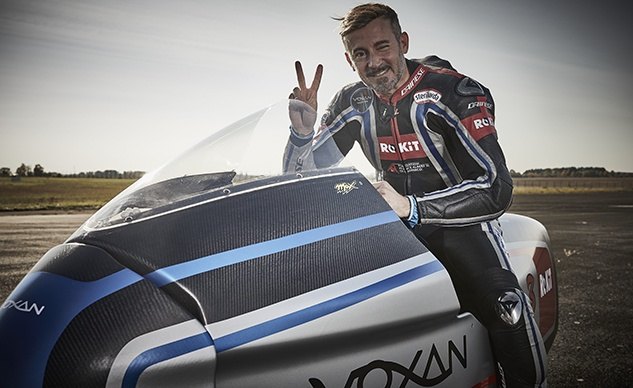
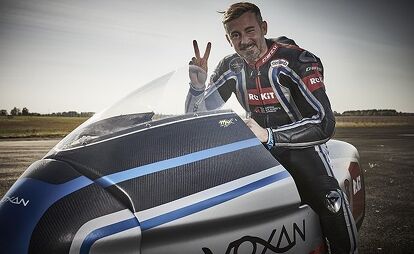








































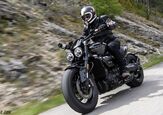

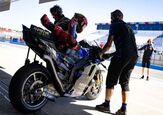

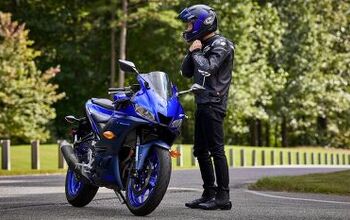


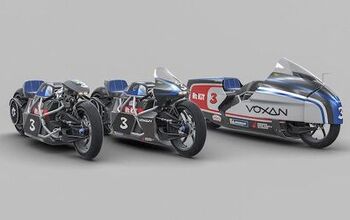














Comments
Join the conversation
Max is used to going fast. ;) Cool that he is still involved in high end two wheel stuff.
Just looking at Double wishbone front end.
How about an electric bike with electric steering ?
Could spark a whole new ergonomic design . Be great on a bagger